Financial Risk Management: Analysis of Collar and Straddle Strategies
VerifiedAdded on 2023/06/03
|6
|1298
|475
Report
AI Summary
This report provides an overview of financial risk management, focusing on the application of options strategies. It delves into two specific strategies: the collar strategy and the straddle strategy. The collar strategy involves buying a put option and selling a call option to protect against price fluctuations, while the straddle strategy involves simultaneously buying a call and a put option at the same strike price. The report explains the mechanics of each strategy, including how to calculate potential profits and losses, and provides practical examples. It also discusses the benefits and shortcomings of each approach, concluding that the straddle strategy is generally more advantageous due to its ability to profit from both upward and downward price movements. The report references several academic sources to support its analysis.

Financial risk management
Paraphrase This Document
Need a fresh take? Get an instant paraphrase of this document with our AI Paraphraser
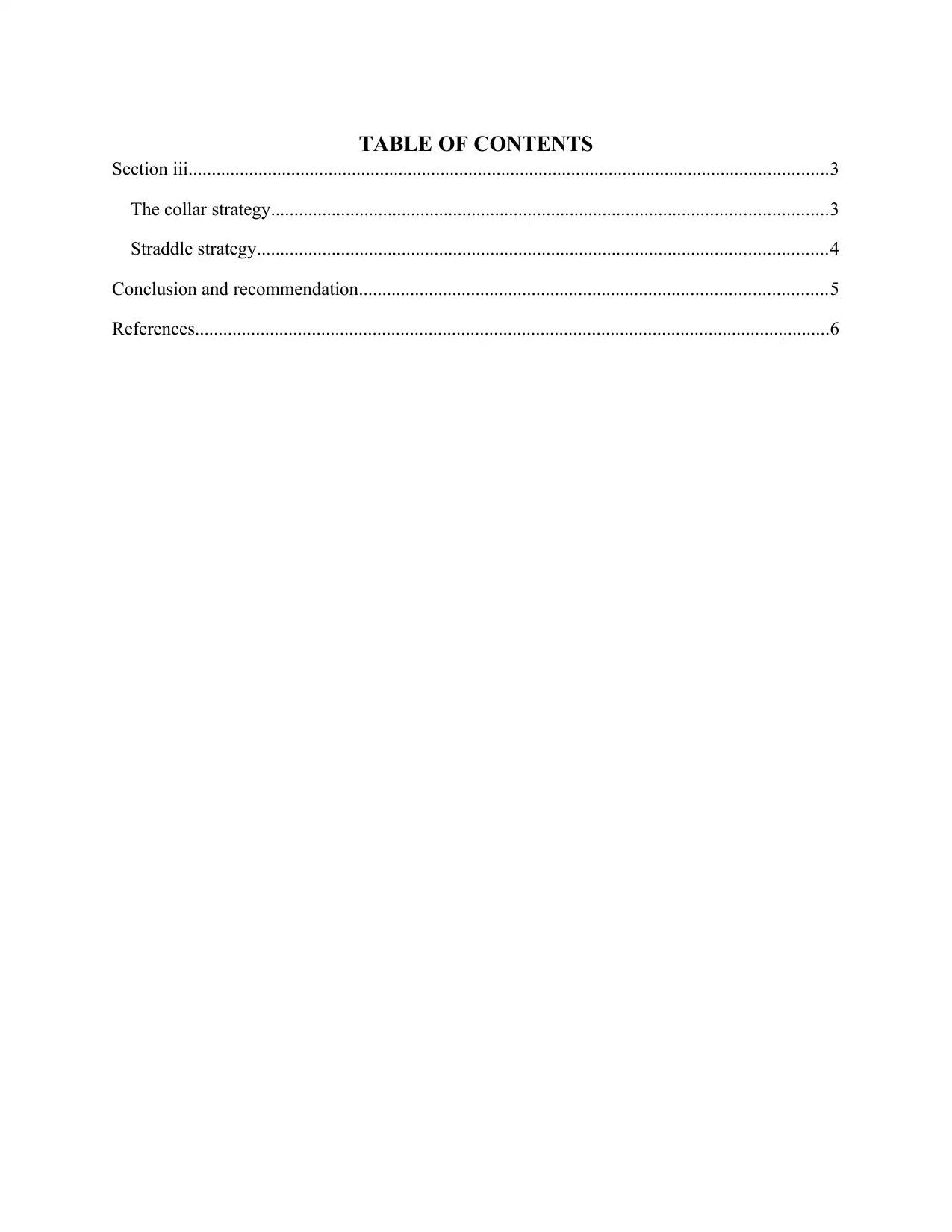
TABLE OF CONTENTS
Section iii.........................................................................................................................................3
The collar strategy.......................................................................................................................3
Straddle strategy..........................................................................................................................4
Conclusion and recommendation....................................................................................................5
References........................................................................................................................................6
Section iii.........................................................................................................................................3
The collar strategy.......................................................................................................................3
Straddle strategy..........................................................................................................................4
Conclusion and recommendation....................................................................................................5
References........................................................................................................................................6
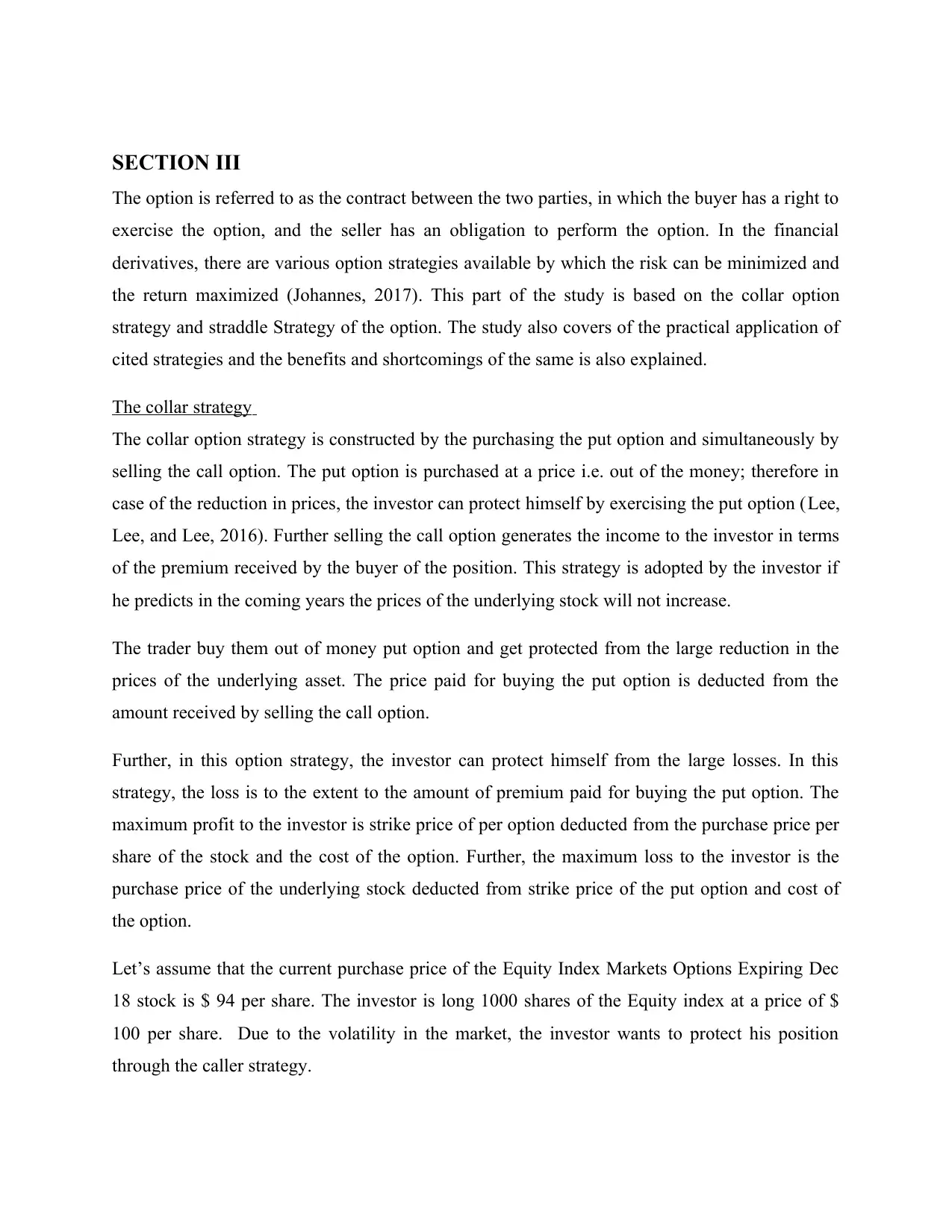
SECTION III
The option is referred to as the contract between the two parties, in which the buyer has a right to
exercise the option, and the seller has an obligation to perform the option. In the financial
derivatives, there are various option strategies available by which the risk can be minimized and
the return maximized (Johannes, 2017). This part of the study is based on the collar option
strategy and straddle Strategy of the option. The study also covers of the practical application of
cited strategies and the benefits and shortcomings of the same is also explained.
The collar strategy
The collar option strategy is constructed by the purchasing the put option and simultaneously by
selling the call option. The put option is purchased at a price i.e. out of the money; therefore in
case of the reduction in prices, the investor can protect himself by exercising the put option (Lee,
Lee, and Lee, 2016). Further selling the call option generates the income to the investor in terms
of the premium received by the buyer of the position. This strategy is adopted by the investor if
he predicts in the coming years the prices of the underlying stock will not increase.
The trader buy them out of money put option and get protected from the large reduction in the
prices of the underlying asset. The price paid for buying the put option is deducted from the
amount received by selling the call option.
Further, in this option strategy, the investor can protect himself from the large losses. In this
strategy, the loss is to the extent to the amount of premium paid for buying the put option. The
maximum profit to the investor is strike price of per option deducted from the purchase price per
share of the stock and the cost of the option. Further, the maximum loss to the investor is the
purchase price of the underlying stock deducted from strike price of the put option and cost of
the option.
Let’s assume that the current purchase price of the Equity Index Markets Options Expiring Dec
18 stock is $ 94 per share. The investor is long 1000 shares of the Equity index at a price of $
100 per share. Due to the volatility in the market, the investor wants to protect his position
through the caller strategy.
The option is referred to as the contract between the two parties, in which the buyer has a right to
exercise the option, and the seller has an obligation to perform the option. In the financial
derivatives, there are various option strategies available by which the risk can be minimized and
the return maximized (Johannes, 2017). This part of the study is based on the collar option
strategy and straddle Strategy of the option. The study also covers of the practical application of
cited strategies and the benefits and shortcomings of the same is also explained.
The collar strategy
The collar option strategy is constructed by the purchasing the put option and simultaneously by
selling the call option. The put option is purchased at a price i.e. out of the money; therefore in
case of the reduction in prices, the investor can protect himself by exercising the put option (Lee,
Lee, and Lee, 2016). Further selling the call option generates the income to the investor in terms
of the premium received by the buyer of the position. This strategy is adopted by the investor if
he predicts in the coming years the prices of the underlying stock will not increase.
The trader buy them out of money put option and get protected from the large reduction in the
prices of the underlying asset. The price paid for buying the put option is deducted from the
amount received by selling the call option.
Further, in this option strategy, the investor can protect himself from the large losses. In this
strategy, the loss is to the extent to the amount of premium paid for buying the put option. The
maximum profit to the investor is strike price of per option deducted from the purchase price per
share of the stock and the cost of the option. Further, the maximum loss to the investor is the
purchase price of the underlying stock deducted from strike price of the put option and cost of
the option.
Let’s assume that the current purchase price of the Equity Index Markets Options Expiring Dec
18 stock is $ 94 per share. The investor is long 1000 shares of the Equity index at a price of $
100 per share. Due to the volatility in the market, the investor wants to protect his position
through the caller strategy.
⊘ This is a preview!⊘
Do you want full access?
Subscribe today to unlock all pages.

Trusted by 1+ million students worldwide
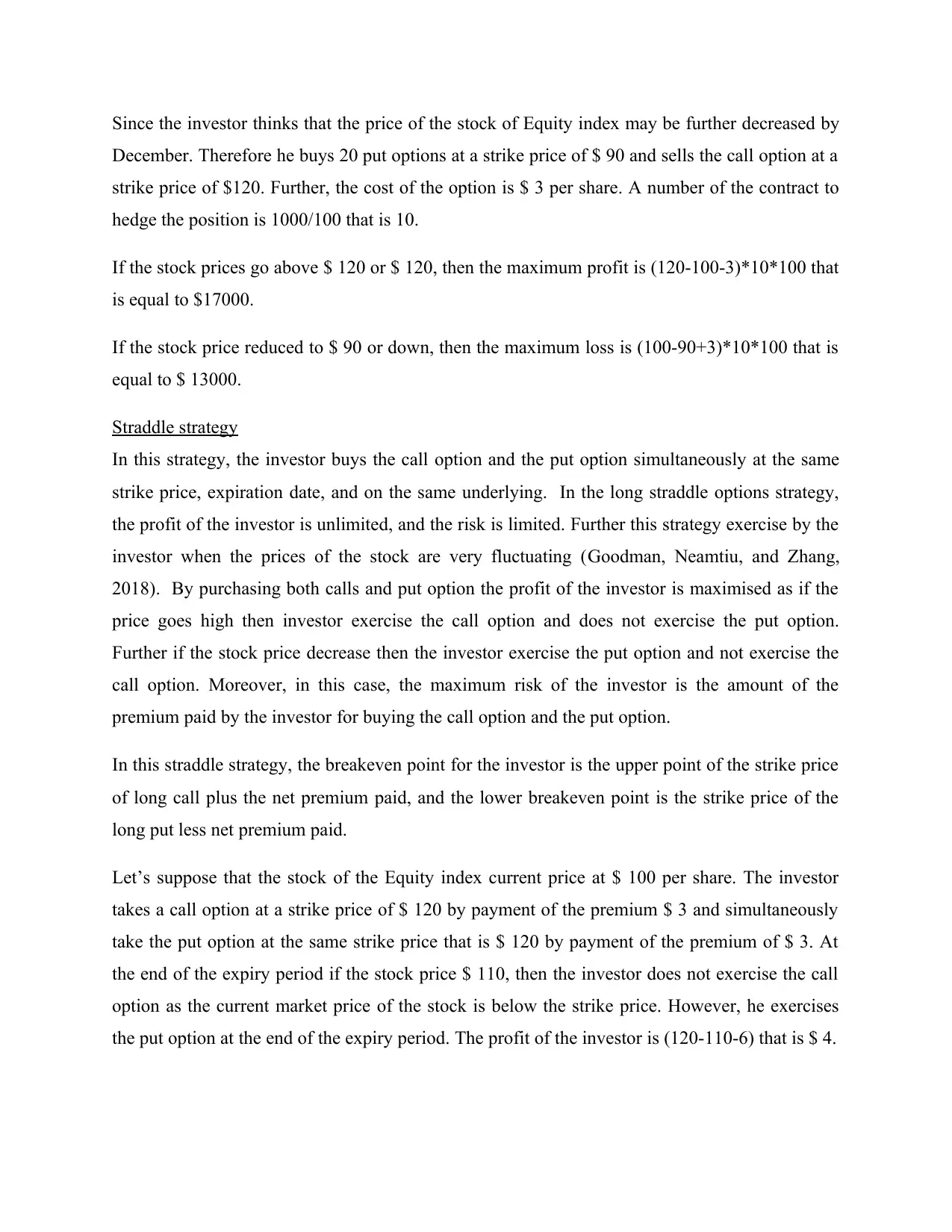
Since the investor thinks that the price of the stock of Equity index may be further decreased by
December. Therefore he buys 20 put options at a strike price of $ 90 and sells the call option at a
strike price of $120. Further, the cost of the option is $ 3 per share. A number of the contract to
hedge the position is 1000/100 that is 10.
If the stock prices go above $ 120 or $ 120, then the maximum profit is (120-100-3)*10*100 that
is equal to $17000.
If the stock price reduced to $ 90 or down, then the maximum loss is (100-90+3)*10*100 that is
equal to $ 13000.
Straddle strategy
In this strategy, the investor buys the call option and the put option simultaneously at the same
strike price, expiration date, and on the same underlying. In the long straddle options strategy,
the profit of the investor is unlimited, and the risk is limited. Further this strategy exercise by the
investor when the prices of the stock are very fluctuating (Goodman, Neamtiu, and Zhang,
2018). By purchasing both calls and put option the profit of the investor is maximised as if the
price goes high then investor exercise the call option and does not exercise the put option.
Further if the stock price decrease then the investor exercise the put option and not exercise the
call option. Moreover, in this case, the maximum risk of the investor is the amount of the
premium paid by the investor for buying the call option and the put option.
In this straddle strategy, the breakeven point for the investor is the upper point of the strike price
of long call plus the net premium paid, and the lower breakeven point is the strike price of the
long put less net premium paid.
Let’s suppose that the stock of the Equity index current price at $ 100 per share. The investor
takes a call option at a strike price of $ 120 by payment of the premium $ 3 and simultaneously
take the put option at the same strike price that is $ 120 by payment of the premium of $ 3. At
the end of the expiry period if the stock price $ 110, then the investor does not exercise the call
option as the current market price of the stock is below the strike price. However, he exercises
the put option at the end of the expiry period. The profit of the investor is (120-110-6) that is $ 4.
December. Therefore he buys 20 put options at a strike price of $ 90 and sells the call option at a
strike price of $120. Further, the cost of the option is $ 3 per share. A number of the contract to
hedge the position is 1000/100 that is 10.
If the stock prices go above $ 120 or $ 120, then the maximum profit is (120-100-3)*10*100 that
is equal to $17000.
If the stock price reduced to $ 90 or down, then the maximum loss is (100-90+3)*10*100 that is
equal to $ 13000.
Straddle strategy
In this strategy, the investor buys the call option and the put option simultaneously at the same
strike price, expiration date, and on the same underlying. In the long straddle options strategy,
the profit of the investor is unlimited, and the risk is limited. Further this strategy exercise by the
investor when the prices of the stock are very fluctuating (Goodman, Neamtiu, and Zhang,
2018). By purchasing both calls and put option the profit of the investor is maximised as if the
price goes high then investor exercise the call option and does not exercise the put option.
Further if the stock price decrease then the investor exercise the put option and not exercise the
call option. Moreover, in this case, the maximum risk of the investor is the amount of the
premium paid by the investor for buying the call option and the put option.
In this straddle strategy, the breakeven point for the investor is the upper point of the strike price
of long call plus the net premium paid, and the lower breakeven point is the strike price of the
long put less net premium paid.
Let’s suppose that the stock of the Equity index current price at $ 100 per share. The investor
takes a call option at a strike price of $ 120 by payment of the premium $ 3 and simultaneously
take the put option at the same strike price that is $ 120 by payment of the premium of $ 3. At
the end of the expiry period if the stock price $ 110, then the investor does not exercise the call
option as the current market price of the stock is below the strike price. However, he exercises
the put option at the end of the expiry period. The profit of the investor is (120-110-6) that is $ 4.
Paraphrase This Document
Need a fresh take? Get an instant paraphrase of this document with our AI Paraphraser
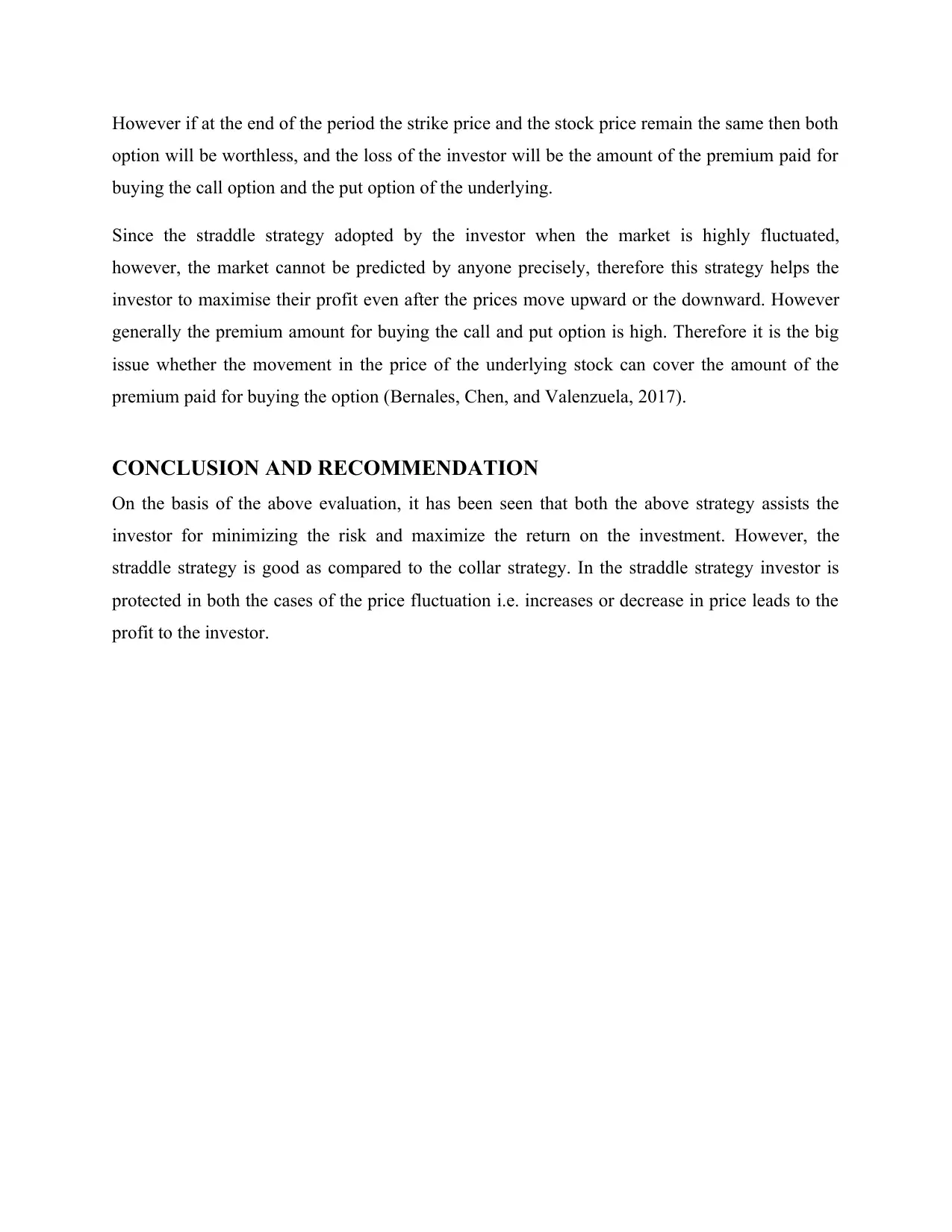
However if at the end of the period the strike price and the stock price remain the same then both
option will be worthless, and the loss of the investor will be the amount of the premium paid for
buying the call option and the put option of the underlying.
Since the straddle strategy adopted by the investor when the market is highly fluctuated,
however, the market cannot be predicted by anyone precisely, therefore this strategy helps the
investor to maximise their profit even after the prices move upward or the downward. However
generally the premium amount for buying the call and put option is high. Therefore it is the big
issue whether the movement in the price of the underlying stock can cover the amount of the
premium paid for buying the option (Bernales, Chen, and Valenzuela, 2017).
CONCLUSION AND RECOMMENDATION
On the basis of the above evaluation, it has been seen that both the above strategy assists the
investor for minimizing the risk and maximize the return on the investment. However, the
straddle strategy is good as compared to the collar strategy. In the straddle strategy investor is
protected in both the cases of the price fluctuation i.e. increases or decrease in price leads to the
profit to the investor.
option will be worthless, and the loss of the investor will be the amount of the premium paid for
buying the call option and the put option of the underlying.
Since the straddle strategy adopted by the investor when the market is highly fluctuated,
however, the market cannot be predicted by anyone precisely, therefore this strategy helps the
investor to maximise their profit even after the prices move upward or the downward. However
generally the premium amount for buying the call and put option is high. Therefore it is the big
issue whether the movement in the price of the underlying stock can cover the amount of the
premium paid for buying the option (Bernales, Chen, and Valenzuela, 2017).
CONCLUSION AND RECOMMENDATION
On the basis of the above evaluation, it has been seen that both the above strategy assists the
investor for minimizing the risk and maximize the return on the investment. However, the
straddle strategy is good as compared to the collar strategy. In the straddle strategy investor is
protected in both the cases of the price fluctuation i.e. increases or decrease in price leads to the
profit to the investor.
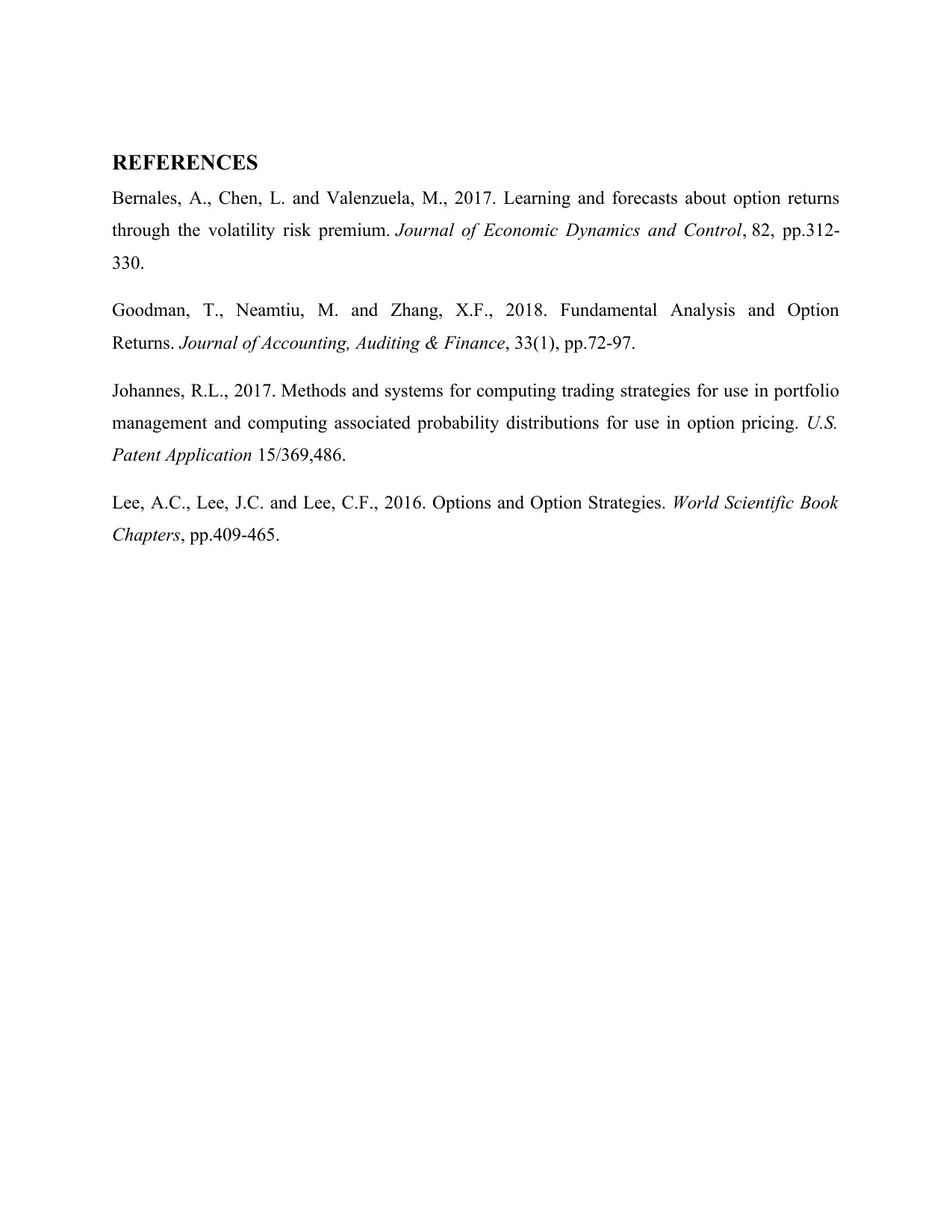
REFERENCES
Bernales, A., Chen, L. and Valenzuela, M., 2017. Learning and forecasts about option returns
through the volatility risk premium. Journal of Economic Dynamics and Control, 82, pp.312-
330.
Goodman, T., Neamtiu, M. and Zhang, X.F., 2018. Fundamental Analysis and Option
Returns. Journal of Accounting, Auditing & Finance, 33(1), pp.72-97.
Johannes, R.L., 2017. Methods and systems for computing trading strategies for use in portfolio
management and computing associated probability distributions for use in option pricing. U.S.
Patent Application 15/369,486.
Lee, A.C., Lee, J.C. and Lee, C.F., 2016. Options and Option Strategies. World Scientific Book
Chapters, pp.409-465.
Bernales, A., Chen, L. and Valenzuela, M., 2017. Learning and forecasts about option returns
through the volatility risk premium. Journal of Economic Dynamics and Control, 82, pp.312-
330.
Goodman, T., Neamtiu, M. and Zhang, X.F., 2018. Fundamental Analysis and Option
Returns. Journal of Accounting, Auditing & Finance, 33(1), pp.72-97.
Johannes, R.L., 2017. Methods and systems for computing trading strategies for use in portfolio
management and computing associated probability distributions for use in option pricing. U.S.
Patent Application 15/369,486.
Lee, A.C., Lee, J.C. and Lee, C.F., 2016. Options and Option Strategies. World Scientific Book
Chapters, pp.409-465.
⊘ This is a preview!⊘
Do you want full access?
Subscribe today to unlock all pages.

Trusted by 1+ million students worldwide
1 out of 6
Related Documents
Your All-in-One AI-Powered Toolkit for Academic Success.
+13062052269
info@desklib.com
Available 24*7 on WhatsApp / Email
![[object Object]](/_next/static/media/star-bottom.7253800d.svg)
Unlock your academic potential
Copyright © 2020–2025 A2Z Services. All Rights Reserved. Developed and managed by ZUCOL.





